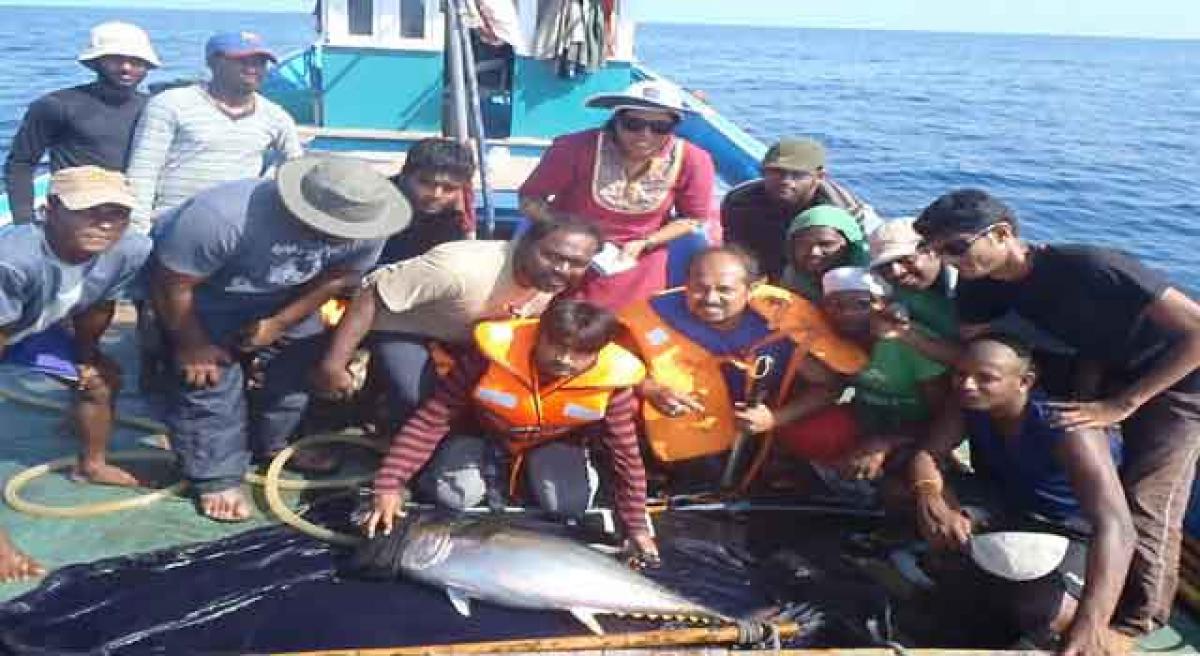Live
- Thriving in tech world: How women can take control of their careers
- STEM hiring to rise by 15-20 pc by 2027: Report
- UK Regulator Accuses Apple and Google of Stifling Mobile Browser Competition
- Tamil Nadu CM Stalin Invites Telangana CM Revanth Reddy for Meeting on Delimitation Impact
- Essential career tips for freshers
- Tips to avoid unnecessary mistakes while studying abroad
- Holi Festival: Liquor Outlets to Remain Closed for Holi in Hyderabad
- iQoo launches Neo 10R model
- Hyderabad: Woman Alleges Caste-Based Harassment by Roommates in Shaikpet
- Markets end on flat note

Pop-up satellite tagging of yellowfin tuna, a pioneering project taken up by the Vizag-based Central Marine Fisheries Research Institute, proved to be a grand success. The tagging programme entitled “Satellite telemetry studies on migration pattern of tuna in Indian Sea (Sattuna)” funded by the Indian National Centre for Ocean Information Service (INCOIS), is first of its kind in Asia and second i
Visakhapatnam: Pop-up satellite tagging of yellowfin tuna, a pioneering project taken up by the Vizag-based Central Marine Fisheries Research Institute, proved to be a grand success. The tagging programme entitled “Satellite telemetry studies on migration pattern of tuna in Indian Sea (Sattuna)” funded by the Indian National Centre for Ocean Information Service (INCOIS), is first of its kind in Asia and second in the world after the Gulf of Mexico.
So far 35 tunas were tagged in the Bay of Bengal off Visakhapatnam and in Arabian Sea off Lakshadweep Islands during the last five years. “This year eight tunas were tagged in the Arabian Sea,” said CMFRI scientist S Ghosh. The pop-up tag each weighing 40 grams is fitted to the second dorsal fin of the fish before releasing into the waters.
Pop-up tagging grand success, claims scientist at CMFRI
The tags have a shelf life ranging from three months to one year and have a release mechanism that causes tag to detach from the fish at a predetermined time and pops up to the sea surface where the data can be recovered via ARGOS system aboard polar orbiting NOAA satellite. The tags are fitted with sensors which collect information on longitude and latitude position of the fish, temperature and pressure of the water and light intensity.
INCOIS decodes the data and sends back to the CMFRI. Yellowfin tunas travelled to Paradeep in the northern direction and Sri Lanka in the south covering a distance of 4,000 km approximately every year, before reaching its home ground off Visakhapatnam. The fish always travelled parallel to the coast at a speed of 75 kmph.
“The five-year data showed us its migration pattern, habitat and its breeding ground,’’ Ghosh said. The reason for tagging yellowfin tuna was due to its high-commercial value in the international market. The location data would be passed on to fishing harbours all over the country for a better harvest.
The Exclusive Economic Zone has 2.78 lakh tonne of tuna, half of which is yellowfin tuna, most sought after in the overseas markets, according to a study. Around 20,000 tonnes of different varieties of shrimp and tuna is exported to European countries every month from Visakhapatnam.
By:K M P Patnaik

© 2025 Hyderabad Media House Limited/The Hans India. All rights reserved. Powered by hocalwire.com







